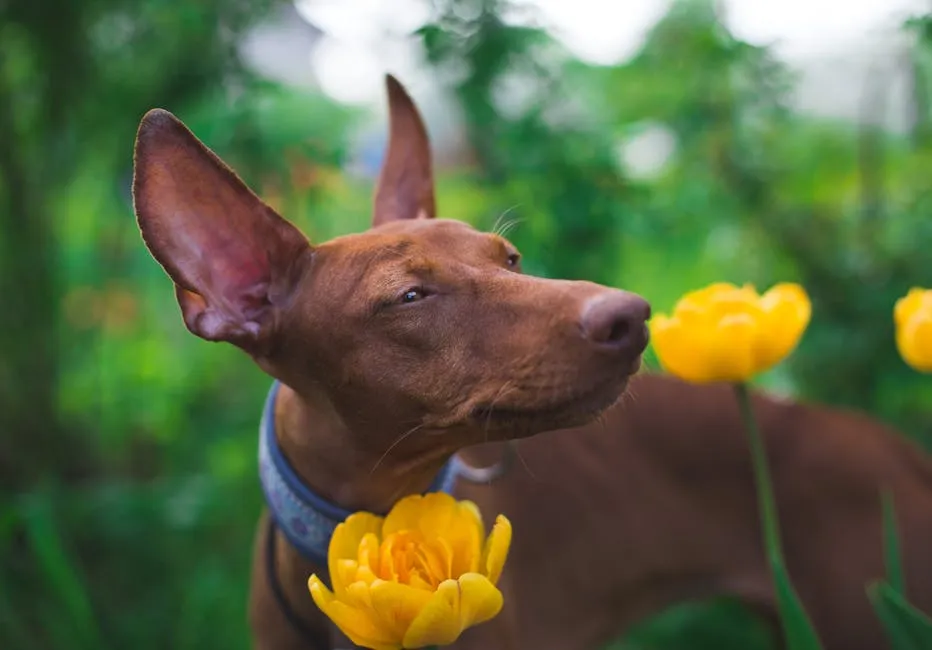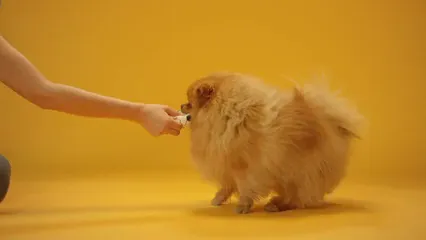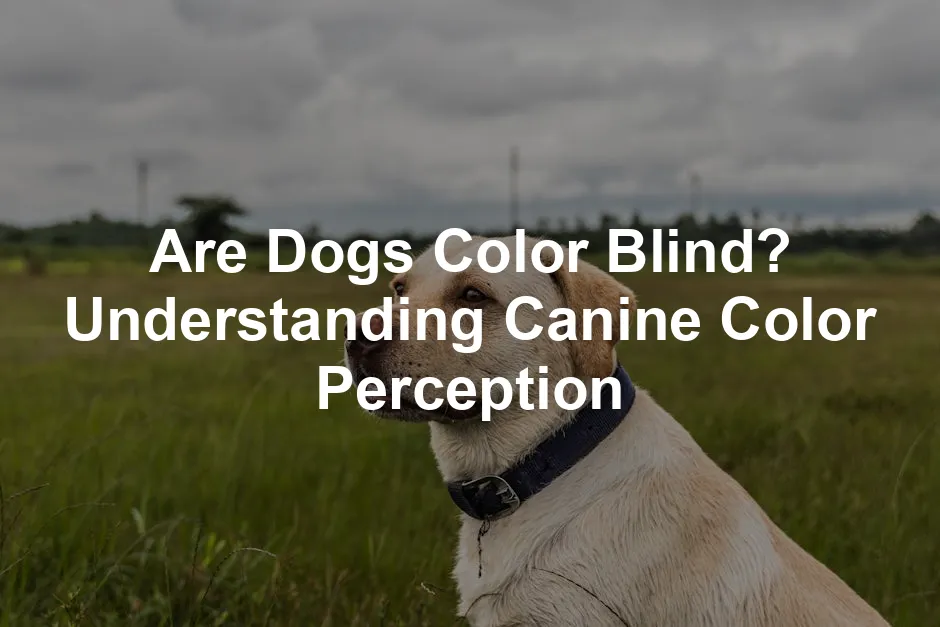Introduction
Many people think dogs are color blind. This is a common misconception. In reality, dogs perceive colors differently than humans. Understanding how dogs see the world is vital for their care and training. It can help you choose the right toys and training methods. Speaking of toys, have you checked out the Blue Dog Toy Ball? It’s a great way to add some color to your dog’s playtime while keeping them entertained!
Summary and Overview
This article aims to clarify color blindness in dogs. We will discuss their ability to perceive colors and how it varies from humans. Dogs have dichromatic vision, meaning they see primarily yellow and blue. They struggle with red and green, which may appear as muted shades. This understanding is crucial for dog owners when selecting toys and training strategies. By knowing what colors dogs can perceive, owners can enhance their pets’ playtime and learning experiences. Using the right colors can make a significant difference in how dogs interact with their environment.

Speaking of enhancing playtime, consider getting an interactive Yellow Dog Frisbee. Not only is it a fun way to engage your dog, but the bright color ensures they can find it easily, even in a field of greens!
Understanding how to manage playtime for your dog can enhance their experience. how to manage playtime for small dogs in multipet households
Understanding Color Blindness
What Is Color Blindness?
Color blindness refers to the inability to distinguish certain colors. It affects how individuals perceive the world around them. In humans, color blindness is typically measured through tests like the Ishihara test. This test uses colored dots to form numbers, allowing one to identify color deficiencies. The most common types of color blindness include dichromacy and trichromacy.
Dichromacy means having only two types of color receptors, while trichromacy means having three. Humans usually have three types of cones sensitive to red, green, and blue. In contrast, dogs have only two types, limiting their color perception. For dog owners, understanding this difference can be crucial in selecting effective training tools, such as a Dog Training Clicker. It can help reinforce positive behaviors in a way that’s visually engaging for your dog.

The biological basis for color perception lies in the cones found in the retina. These specialized cells detect different wavelengths of light. The brain then interprets these signals, allowing us to see colors.
Understanding color blindness helps us appreciate how different beings perceive their surroundings. It also sheds light on the visual capabilities of various species, including dogs. If you’re looking to keep your dog entertained, consider an Interactive Dog Puzzle Toy. It’s a fun way to stimulate your dog’s mind and keep them busy!
How Dogs’ Eyes Work
Dogs have unique eyes that play a big role in how they see the world. The anatomy of a dog’s eye includes two main types of light-sensitive cells: rods and cones. Rods help detect motion and work well in low light, while cones are responsible for color perception.
Unlike humans, who have three types of cones, dogs possess only two. This gives them dichromatic vision, meaning they primarily see two colors. The two types of cones in dogs detect wavelengths corresponding to blue and yellow. This arrangement limits their ability to see a full color spectrum. A Dog Harness in Bright Colors can help keep your dog safe and visible during walks!

Evolutionarily, dogs developed these visual capabilities to assist them as hunters. They needed to see well in dim light and spot fast-moving prey. Their enhanced rod cells help them detect movement, while their limited cone cells focus on blue and yellow hues. This combination allows dogs to thrive in their environments.
Can Dogs See Color?
The Color Spectrum for Dogs
So, what colors can dogs actually see? Research shows that dogs can distinguish between blue and yellow. These colors stand out to them. For example, a blue ball on green grass is easy for a dog to spot.
However, colors like red and green are a different story. To dogs, red often appears as a dark brown or grayish hue. Green may also look muted. This altered perception affects how dogs interact with their surroundings. A bright red toy may blend into the grass, making it hard for a dog to find.

Imagine throwing a red frisbee into a green field. Your dog might run around, confused, while a yellow frisbee would be easily visible. To avoid such confusion, consider a Dog Chew Toy that comes in blue or yellow. It will keep your dog engaged and happy!
Comparisons with Human Vision
Humans enjoy trichromatic vision, allowing us to see a vast array of colors. Our three types of cones enable us to perceive combinations of red, green, and blue. In contrast, dogs’ dichromatic vision limits them to blue and yellow. This fundamental difference affects not just their perception of color, but also their behavior and interaction with their environment.
For instance, while you might admire a vibrant red flower, your dog sees it as a dull shade. Understanding these differences helps us appreciate our dogs’ perspectives and choices. It can even guide us in selecting toys that enhance their play experience. A Dog Training Mat in bright colors can also make training sessions more engaging!

Practical Implications for Dog Owners
Choosing the Right Toys
When selecting toys for your dog, color matters. Dogs primarily see blue and yellow hues. This means toys in these colors are more visible to them. For instance, a bright blue ball stands out against green grass, making it easier for your dog to spot. A Dog Bed in Blue or Yellow can also enhance your dog’s comfort while adding a splash of color to your home!

On the other hand, colors like red and green can be misleading. To a dog, a red toy may appear as a dull brown, blending into the grass. Imagine tossing a red frisbee into a field; your dog might struggle to locate it. Choosing toys that are blue or yellow ensures your dog enjoys playtime without frustration. Speaking of convenience, a Dog Waste Bags Dispenser can make clean-up a breeze!
Selecting the right toys can significantly enhance your dog’s playtime experience. best powder green mussels for small dogs
Training Considerations
Color perception also impacts training methods. Since dogs respond best to blue and yellow, using these colors as cues can enhance communication. For example, try using a blue mat as a target during training sessions. This clear visual cue helps your dog understand what you want. To further support your training, consider a Dog Training Whistle that can help reinforce commands.

Additionally, incorporating colored treats can be effective. If your dog learns to associate a yellow treat with positive reinforcement, it can improve their responsiveness. By considering color in training, you can create a more engaging and effective learning environment for your furry friend. You might also want to check out a Dog Treats in Bright Colors to add some fun to their training!
Myths and Misconceptions
Debunking the Black and White Myth
Many believe that dogs see only in black and white. This idea has persisted for years, but it’s far from accurate. While dogs do not perceive colors the way humans do, they are not completely color blind. Research shows that dogs can see shades of blue and yellow.

This misconception likely stems from early studies that focused solely on the limited color perception of dogs. However, modern research reveals that dogs experience a form of color vision similar to humans with red-green color blindness. They may see a muted world, but it’s not just black and white.
Understanding this fact is crucial for dog owners. It helps you choose appropriate toys and training tools that align with your dog’s visual abilities. By recognizing that dogs can see some colors, you can foster a more enriching environment for your pet. To keep your dog safe, consider a Reflective Dog Collar for evening walks.
Scientific Studies on Dog Color Vision
Overview of Key Research Findings
Recent studies have significantly improved our understanding of how dogs perceive color. One notable study utilized a modified Ishihara test, traditionally used for human color blindness. Researchers tested dogs by showing them colored images, particularly focusing on how they reacted to various shades of red and green. The findings confirmed that dogs exhibited responses similar to those of humans with red-green color blindness. This means they struggle to distinguish these colors, seeing them as muted shades instead.

Another pivotal study examined the structure of a dog’s retina. It revealed that dogs possess only two types of cone cells. These cones are sensitive primarily to blue and yellow wavelengths. This limited spectrum of color perception highlights why dogs do not see the same vivid colors humans do. Their world is likely filled with shades of blue and yellow, while reds and greens appear washed out or grayish.
Implications of Research
These studies reveal fascinating insights into canine adaptability. Understanding dogs’ color vision can help us create better environments for them. For instance, using blue and yellow toys can enhance their playtime experiences. Knowing how dogs perceive color also sheds light on their evolutionary traits. As hunters, their vision is optimized for detecting motion in dim light rather than vibrant colors. A Dog Cooling Mat can also provide comfort during hot days!

Ongoing research continues to deepen our understanding of canine vision. It emphasizes how dogs interpret their surroundings through a combination of visual and olfactory cues. This knowledge not only enhances our relationship with dogs but also informs training strategies and enriches their daily lives.
By acknowledging the nuances of canine color perception, we can appreciate the unique ways dogs interact with their environment, ultimately leading to better care and companionship. Don’t forget to check out a Dog Grooming Brush to keep your pup looking sharp!
Conclusion
In summary, dogs are not completely color blind. They have dichromatic vision, meaning they primarily perceive blue and yellow hues. Understanding this unique color perception is essential for dog owners. It allows you to choose toys and training methods that align with your dog’s visual capabilities. By considering how dogs see the world, you can create a more engaging and enriching environment for them. Take a moment to observe your dog’s reactions to different colors. You may discover new ways to enhance their playtime and training experiences! And for those special occasions, a Dog Costume for Holidays can make them the star of the party!
FAQs
Are dogs completely color blind?
Many believe dogs see only in black and white. This common belief is inaccurate. Dogs can perceive some colors, primarily blue and yellow, but struggle with red and green. Their vision is similar to that of humans with red-green color blindness.
What colors do dogs see best?
Dogs excel at distinguishing blue and yellow. These colors stand out more prominently in their vision. Toys or objects in these hues are easier for dogs to recognize and engage with during play.
How does dog color vision compare to human vision?
Humans have trichromatic vision, seeing red, green, and blue, while dogs have dichromatic vision. This means dogs see a limited range of colors and perceive reds and greens as muted shades. Their vision also lacks the sharpness of human sight.
Can color affect a dog’s behavior or training?
Yes, color can influence training strategies. Using blue or yellow cues can enhance communication. Recognizing how dogs perceive colors helps tailor training methods for better results.
Do all dogs see colors the same way?
All dogs share similar color perception due to their eye structure. However, individual variations can occur among different breeds or specific dogs. Factors like age and health can also influence how well a dog perceives colors.
Please let us know what you think about our content by leaving a comment down below!
Thank you for reading till here 🙂
All images from Pexels





